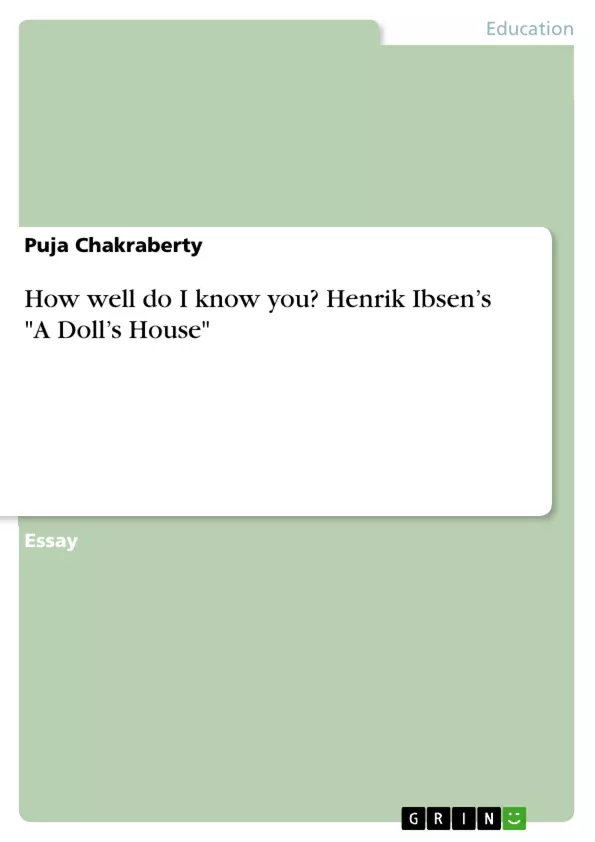Henrik Ibsen’s classic ‘A Doll’s House’, which is also called a modern tragedy, raises questions against certain established notions such as love and marriage, faith and function. The present essay endeavours to elaborate upon these notions with special allusion to the problem play, which is also Ibsen’s masterpiece.
Inhaltsverzeichnis (Table of Contents)
- Introduction
- A Doll's House: A Reflection of Established Notions
- The Power of Illusion: Nora's Blindfold
- Love as a Fair Bargain: Helmer's Perspective
- The Price of Unconditional Love: Nora's Selflessness
- The Fall from Paradise: Helmer's Illness and Nora's Dilemma
- The Threat of Revelation: Krogstad's Blackmail
- The Burden of Deception: Nora's Desperate Search for a Solution
- The Crumbling Foundation: Helmer's Reaction and Nora's Awakening
- The Unexpected Turn: Krogstad's Redemption
Zielsetzung und Themenschwerpunkte (Objectives and Key Themes)
This essay explores the themes of love, marriage, faith, and function in Henrik Ibsen's "A Doll's House," using the play as a lens to analyze traditional societal expectations and their impact on individuals, particularly women. The essay aims to highlight the hypocrisy and limitations of these established notions, ultimately arguing for greater freedom and autonomy for women.- The Power Dynamics in Marriage
- The Illusion of Love and its Limitations
- The Impact of Social Expectations on Individuals
- The Struggle for Female Identity and Autonomy
- The Nature of Deception and its Consequences
Zusammenfassung der Kapitel (Chapter Summaries)
This section will provide summaries of the chapters of the essay, excluding the conclusion, final chapter, or any sections containing major revelations or spoilers.- **Introduction:** Introduces the essay's focus on "A Doll's House" and its exploration of established notions of love, marriage, faith, and function.
- **A Doll's House: A Reflection of Established Notions:** Explores the play's depiction of a seemingly idyllic household and the underlying tensions that exist within it, highlighting the control and limitations imposed on women.
- **The Power of Illusion: Nora's Blindfold:** Examines Nora's seemingly submissive nature and her acceptance of Helmer's control, suggesting that she has adopted a blindfold to societal expectations.
- **Love as a Fair Bargain: Helmer's Perspective:** Analyzes Helmer's view of love as a transaction, where he expects obedience and submission from his wife in exchange for his love and protection.
- **The Price of Unconditional Love: Nora's Selflessness:** Focuses on Nora's selflessness, her dedication to Helmer and her children, and her unwavering faith in the institution of marriage.
- **The Fall from Paradise: Helmer's Illness and Nora's Dilemma:** Discusses the disruption of this seemingly perfect world when Helmer falls ill, leading Nora into a precarious financial situation that forces her to make difficult choices.
- **The Threat of Revelation: Krogstad's Blackmail:** Introduces Krogstad, a character who poses a threat to Nora's carefully constructed world by revealing her secret and threatening her reputation.
- **The Burden of Deception: Nora's Desperate Search for a Solution:** Explores Nora's efforts to navigate the blackmail, her desperate search for a solution, and her reliance on her friend, Mrs. Linde, for support.
- **The Crumbling Foundation: Helmer's Reaction and Nora's Awakening:** Focuses on the devastating consequences of Helmer's reaction to Nora's secret, leading to a dramatic awakening for Nora as she realizes her own position within the marriage.
- **The Unexpected Turn: Krogstad's Redemption:** Outlines Krogstad's unexpected change of heart and his decision to protect Nora, ultimately setting the stage for the play's climax.
Schlüsselwörter (Keywords)
This essay explores the complex themes of love, marriage, and societal expectations in Henrik Ibsen's "A Doll's House." Key terms and concepts include: power dynamics, illusion of love, female autonomy, social constraints, and the impact of deception. The essay utilizes the play's characters, particularly Nora and Helmer, to highlight the hypocrisy and limitations of traditional notions of marriage and womanhood.
Excerpt out of 8 pages
- scroll top
- Quote paper
- Puja Chakraberty (Author), 2014, How well do I know you? Henrik Ibsen’s "A Doll’s House", Munich, GRIN Verlag, https://www.grin.com/document/281047
Look inside the ebook



